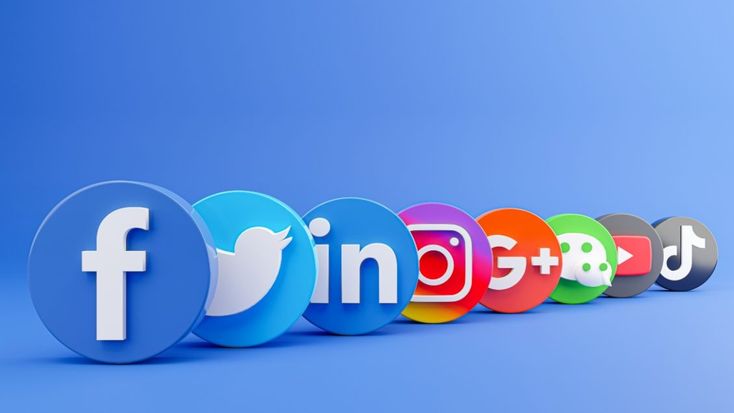Social media is a critical component of modern marketing strategies. With billions of active users, these platforms offer unparalleled opportunities to reach and engage with your target audience. As we head into 2024, staying updated on the most popular and influential social media sites is essential to maximize your brand’s online presence. Here are the top 23 social media apps and platforms to consider for your brand in 2024.
1. Facebook — 3.05 Billion MAUs
Facebook remains the giant in the social media landscape with over 3 billion monthly active users (MAUs). It’s a versatile platform suitable for various content, including text updates, photos, videos, and live streams. Facebook’s extensive advertising tools allow businesses to target specific demographics, making it an essential platform for brand awareness and customer engagement.
2. WhatsApp — 2.78 Billion MAUs
WhatsApp, primarily a messaging app, has become a powerful tool for businesses. With features like WhatsApp Business, brands can create business profiles, automate responses, and use interactive messaging to engage with customers directly. The app’s wide reach and high engagement rates make it an excellent platform for customer support and direct marketing.
3. YouTube — 2.49 Billion MAUs
YouTube is the leading video-sharing platform globally. With over 2 billion users, it’s perfect for brands looking to create and share video content. YouTube offers various ad formats, such as pre-roll ads and sponsored content, providing numerous opportunities for brands to reach a vast audience. Educational videos, product demonstrations, and behind-the-scenes content perform exceptionally well on this platform.
4. Instagram — 2.04 Billion MAUs
Instagram continues to be a favorite among brands, especially those targeting younger demographics. Known for its visual content, Instagram offers features like Stories, Reels, and IGTV, which provide multiple ways to engage with followers. Influencer marketing is particularly effective on Instagram, and the platform’s robust shopping features make it ideal for e-commerce brands.
5. WeChat — 1.32 Billion MAUs
WeChat is more than just a messaging app; it’s a comprehensive platform that includes social media, mobile payments, and other services. Particularly popular in China, WeChat offers brands a unique way to engage with customers through mini-programs, official accounts, and targeted advertising. For brands looking to enter the Chinese market, WeChat is indispensable.
6. TikTok — 1.22 Billion MAUs
TikTok’s explosive growth has made it a key player in social media. Known for its short-form video content, TikTok is perfect for brands aiming to create viral content and reach a younger audience. The platform’s algorithm promotes creative and engaging content, making it easier for brands to gain visibility. Influencer partnerships and creative challenges are particularly effective strategies on TikTok.
7. Telegram — 800 Million MAUs
Telegram is a messaging app known for its focus on privacy and security. It offers unique features like channels and bots, which can be leveraged by brands for broadcasting messages and automating customer interactions. Telegram’s growing user base and high engagement rates make it a valuable platform for direct communication and community building.
8. Snapchat — 750 Million MAUs
Snapchat is a popular platform among younger users, known for its disappearing messages and creative filters. Brands can use Snapchat to create engaging content through Stories and ads. The platform’s augmented reality features and location-based marketing tools offer unique opportunities for brands to connect with their audience in fun and interactive ways.
9. Kuaishou — 673 Million MAUs
Kuaishou, a leading short video platform in China, is known for its focus on everyday life and user-generated content. It offers brands the opportunity to reach a broad audience through live streaming, short videos, and e-commerce integrations. For brands targeting the Chinese market, Kuaishou is an essential platform to consider.
10. Sina Weibo — 599 Million MAUs
Sina Weibo is a microblogging platform often compared to Twitter. It’s highly popular in China and allows users to post multimedia content, engage with others, and follow trends. Brands can leverage Weibo’s advertising options and influencer partnerships to reach a large and active user base, making it a valuable tool for social media marketing in China.
11. QQ — 571 Million MAUs
QQ, another major Chinese platform, started as an instant messaging service and has evolved into a comprehensive social media network. It offers features like chat groups, gaming, and mobile payments. For brands, QQ provides opportunities to engage with users through branded content, advertising, and community building.
12. Douyin (Chinese TikTok) — 558 Million MAUs
Douyin, the Chinese counterpart to TikTok, boasts a massive user base and is a powerhouse for short-form video content in China. Brands can leverage Douyin’s robust features, such as live streaming, in-app shopping, and interactive challenges, to create compelling content and drive engagement with Chinese audiences.
13. X (formerly Twitter) — 550 Million MAUs
Twitter, now rebranded as X, remains a critical platform for real-time updates and engagement. With its fast-paced environment, it’s ideal for brands looking to share news, engage in conversations, and build a loyal following. Twitter’s advertising options and analytics tools allow brands to target specific audiences and measure the impact of their campaigns effectively.
14. Pinterest — 465 Million MAUs
Pinterest is a visual discovery and bookmarking platform that is particularly popular among users looking for inspiration and ideas. Brands in industries such as fashion, home decor, and food can benefit greatly from Pinterest’s visual format. The platform’s shopping features and targeted ads make it an excellent tool for driving traffic and sales.
15. Reddit — 430 Million MAUs
Reddit is a community-driven platform where users engage in discussions on a wide range of topics. Brands can tap into Reddit’s highly engaged user base by participating in relevant subreddits, hosting AMAs (Ask Me Anything), and creating authentic content that resonates with the community. Reddit’s advertising options also allow for targeted campaigns that can drive engagement and brand awareness.
16. LinkedIn — 424 Million MAUs
LinkedIn is the go-to platform for professionals and businesses. It’s an essential tool for B2B marketing, networking, and recruitment. Brands can use LinkedIn to share industry insights, publish thought leadership content, and engage with professionals through targeted advertising and sponsored content. LinkedIn’s robust analytics tools also help measure the effectiveness of campaigns.
17. Quora — 300 Million MAUs
Quora is a question-and-answer platform where users seek expert advice and insights. Brands can establish themselves as thought leaders by answering relevant questions and sharing valuable information. Quora’s advertising options, such as promoted answers and targeted ads, allow brands to reach users who are actively seeking solutions related to their industry.
18. Discord — 154 Million MAUs
Discord is a communication platform initially popular among gamers but is now widely used by various communities. Brands can create their servers to build dedicated communities, host events, and engage with users in real-time. Discord’s voice, video, and text communication features make it a versatile tool for fostering strong community relationships.
19. Twitch — 140 Million MAUs
Twitch is a live streaming platform primarily known for gaming content, but it has expanded to include various types of live streams such as music, art, and talk shows. Brands can sponsor streamers, create their channels, and engage with a highly interactive audience. Twitch’s unique culture and real-time interaction capabilities make it a powerful platform for building brand loyalty and engagement.
20. Tumblr — 135 Million MAUs
Tumblr is a microblogging platform known for its creative and artistic community. Brands can use Tumblr to share multimedia content, engage with niche audiences, and build a unique brand identity. The platform’s customizable features and strong community culture offer opportunities for brands to connect with users on a more personal and creative level.
21. Threads by Instagram — 100 Million MAUs
Threads by Instagram is a messaging app designed for close friends. It offers brands a way to engage with their most loyal followers through private, intimate communication. Brands can use Threads to share exclusive content, provide personalized customer service, and foster a sense of community among their top supporters.
22. Mastodon — 1.7 Million MAUs
Mastodon is a decentralized social network that operates on independent servers. It offers users greater control over their data and a more personalized social media experience. Brands can create their servers or join existing ones to engage with niche communities. Mastodon’s emphasis on privacy and user control makes it an attractive platform for brands looking to build trust and authenticity.
23. Bluesky — MAU Unknown
Bluesky is a new social media platform developed by Twitter’s founder Jack Dorsey. It aims to create a decentralized social media ecosystem. While its user base is currently unknown, Bluesky’s innovative approach to social media could make it a significant player in the future. Brands should keep an eye on Bluesky as it develops and consider early adoption to stay ahead of the curve.
24. Clubhouse — MAU Unknown
Clubhouse is an audio-based social media app where users can join virtual rooms to listen to or participate in live discussions. It gained popularity for its exclusivity and real-time interaction features. Brands can use Clubhouse to host discussions, share industry insights, and engage with audiences in a more personal and interactive way. The platform’s emphasis on voice communication offers a unique opportunity to build a closer connection with followers.
Conclusion
Navigating the social media landscape can be challenging, but understanding the unique features and audiences of each platform can help brands effectively reach and engage with their target market. From giants like Facebook and YouTube to emerging platforms like Bluesky, each site offers distinct opportunities for brand growth and engagement. By strategically leveraging these social media platforms, brands can enhance their online presence, build stronger relationships with their audience, and achieve their marketing goals in 2024 and beyond.
- How Does Automated Scheduling Save Time and Boost Engagement? - April 16, 2025
- 21 Delicious High Protein Foods - May 31, 2024
- Black Seed Oil: Health and Beauty Benefits - May 30, 2024




